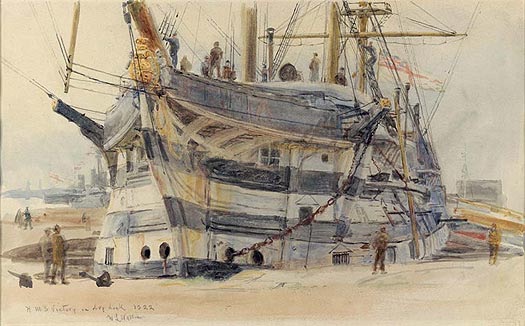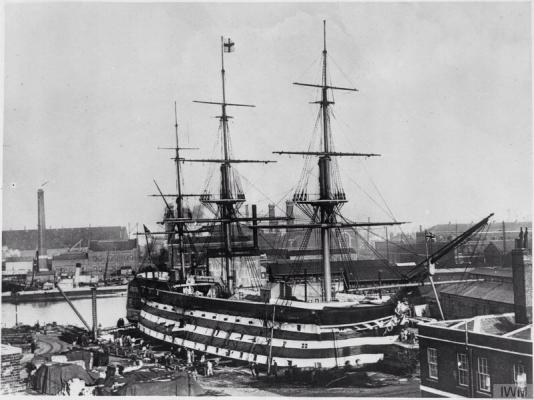-
Posts
3,486 -
Joined
-
Last visited
Content Type
Profiles
Forums
Gallery
Events
Everything posted by amateur
-
Some watercolours suggest that they took the black-white striping to the limit.... (This one is labelled victory in drydock, 1922) Jan
-
You're not just doing the outside, arent't you? We would like to see the interior as well Jan
-
Undoubtedly to something beautifull, and to som emore destruction along the route. Perhaps a Vic in the situation of 1890, or one in the situation of 2025? Jan
-

ROYAL CAROLINE 1749 by Doris - 1:40 - CARD
amateur replied to DORIS's topic in - Build logs for subjects built 1501 - 1750
We've run out of superlatives. We should think of a new one that realy captures your skills and results! Caroline has become a real stunner. It's a pity we can't see her real life, would love to.... Jan- 883 replies
-
- royal caroline
- ship of the line
-
(and 1 more)
Tagged with:
-

Gripen 1591 by NAZGÛL (Matti)
amateur replied to NAZGÛL's topic in - Build logs for subjects built 1501 - 1750
And www.dewillembarentsz.nl (also dutch only....) -

Gripen 1591 by NAZGÛL (Matti)
amateur replied to NAZGÛL's topic in - Build logs for subjects built 1501 - 1750
You know the site vocsite.nl? It is onlu in dutch, but informative for those who are able to read Dutch. Jan -
Guess you have to share ths title with Martanek, (very well known from some absolutely ridiculously detailed paper models in MSW1. A shame he dropped out after the crash. Jan
-
I would say: write whatever you like, and when you like. I already learned something from your picture: Fitz was way larger than I ever imagined. These is a guy (andy) somewhere around on MSW (inless he is soemwhere sailing on the grate lakes) who alos did quite a lot of talking on these ships, doing at the moment a slightly larger scale model of a smaller laker. I like these ships (don't ask me why) so I will follow this one. Jan
- 40 replies
-
- edmund fitzgerald
- iron shipwrights
-
(and 1 more)
Tagged with:
-
Hi Daniel, We're absoluterly not surprised. Only a bit curious how and were your carefully applied coppering came loose, and whether or not the remainder feels itself out of palace as soon as the revised version is applied. Wouldn't surprise me if that also jumps of the hull, as soon as they realize how version 1.0 they actually are Jan
-
And the hole in the middle of the bulkhead is to help allignment, or...? Jan
- 191 replies
-
- young america
- clipper
-
(and 1 more)
Tagged with:
-

Gripen 1591 by NAZGÛL (Matti)
amateur replied to NAZGÛL's topic in - Build logs for subjects built 1501 - 1750
Hi Marcus, Problem is, the 'ship-types' weren't that closely defined. Many of the "larger" ships of that period were classified as 'Jacht': the ships of Barentz were, as well as Duyfken. These ships were around 1600, a relatively small, presumably fast sailers. Half Moon also classifies in this group. I checked, and Eendracht (1615) is also referred to as a Jacht. Around 1610, also the name Pinas(se) was used for these ships. Thse PInas evolves into the larger 'spiegelretourschepen' of the VOC, as well as into the more purpose build Men of War of the Admiralities. With respect ot size: these ships were measued and classifed based on 'lasts' (a measure referring to both space (i.e. cubic something) as well as weight). There seems to be no clear one-to-one relation from 'last' to 'length'. The ships of Barenz were around 30 last, and did presumably measure aroudn 70 ft. (according to Hoving). The Eendracht was reported as 250 last, but the measuring system for men of war did not follow the same rules as for general purpose ships: there is no way you can recompute the size of Duyfken to that of Eendracht, using the size of both ships as measured in lasts.According to Wiki (...) the ship measured 103 feet, and had 30 guns. My amateurish guess would be that Eendracht would look far more like a ship like Batavia than Duyfken (no way you get 30 guns on a single-decked ship as Duyfken. (compare the pinas of Tasman as drawn by Hoving) Jan -
Splitting lengthwise? He is making a negative mould to fabricate the actula hull. Splitting lengthwise would result in a seam that can be masked relatively easy. Jan
- 434 replies
-
- pelikaan
- beamtrawler
-
(and 2 more)
Tagged with:
-
Just wondering: can you get the plug out of theplastic hull when the plastic formed over the hull. Jan
- 434 replies
-
- pelikaan
- beamtrawler
-
(and 2 more)
Tagged with:
-
Sorry for asking, but does this meanriing the existi g copperplates off, and replacing them with better ones? Jan
-
There is one completed cutter using this admirality-plug, in the log of Remco. I can't remember of any issues with the plug from that log. Jan
-
It's notan improvement,the new ones are coming from another world compared to your original Jan
- 119 replies
-
- la reale de france
- heller
-
(and 1 more)
Tagged with:
-
As always: it may depend on your ship and the period concerned. As far as I know, the part around the masttop,is always seized, asis the part that is turned around the deadeyes. In many countries/periods, the most forward shroud is seized over its full length, but as always, there are exceptions. Jan
-
Instructive, impressive, what else? It would be a shame not to get to the next deck. It would equally be a shame to cover this deck. I thinkthat's what they call a dilimma.... Jan
-

Pandora by marsalv - FINISHED - 1:52
amateur replied to marsalv's topic in - Build logs for subjects built 1751 - 1800
Nice! Question: what made you decide for the somewhat unusual scale of 1:52, in stead of a 1:48? Jan -
We dont use 1cent pieces on this side of the border, so igot myself a tictac to get the dimensions right.... It's becoming frightening.... Jan
-

DelftShip ship design software
amateur replied to lehmann's topic in CAD and 3D Modelling/Drafting Plans with Software
I made some starts inthis program, and i gave up. I can'tget the hull in a reasonable form Some others dowo derfull things with it. In the newest book of hoving at Seawatchbooks, there are some ilustrations done with delfship. They look quite hightech Jan -
We're in for 2 -3 (to be determined) interesting years. Jan
- 2,625 replies
-
- kaiser wilhelm der grosse
- passenger steamer
-
(and 1 more)
Tagged with:
About us
Modelshipworld - Advancing Ship Modeling through Research
SSL Secured
Your security is important for us so this Website is SSL-Secured
NRG Mailing Address
Nautical Research Guild
237 South Lincoln Street
Westmont IL, 60559-1917
Model Ship World ® and the MSW logo are Registered Trademarks, and belong to the Nautical Research Guild (United States Patent and Trademark Office: No. 6,929,264 & No. 6,929,274, registered Dec. 20, 2022)
Helpful Links
About the NRG
If you enjoy building ship models that are historically accurate as well as beautiful, then The Nautical Research Guild (NRG) is just right for you.
The Guild is a non-profit educational organization whose mission is to “Advance Ship Modeling Through Research”. We provide support to our members in their efforts to raise the quality of their model ships.
The Nautical Research Guild has published our world-renowned quarterly magazine, The Nautical Research Journal, since 1955. The pages of the Journal are full of articles by accomplished ship modelers who show you how they create those exquisite details on their models, and by maritime historians who show you the correct details to build. The Journal is available in both print and digital editions. Go to the NRG web site (www.thenrg.org) to download a complimentary digital copy of the Journal. The NRG also publishes plan sets, books and compilations of back issues of the Journal and the former Ships in Scale and Model Ship Builder magazines.




